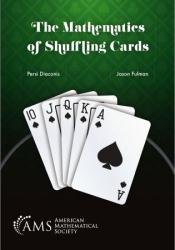The Mathematics of Shuffling Cards
- Добавил: literator
- Дата: 27-04-2023, 01:50
- Комментариев: 0
 Название: The Mathematics of Shuffling Cards
Название: The Mathematics of Shuffling CardsАвтор: Persi Diaconis, Jason Fulman
Издательство: American Mathematical Society
Год: 2023
Страниц: 360
Язык: английский
Формат: pdf (true)
Размер: 43.5 MB
This book gives a lively development of the mathematics needed to answer the question, “How many times should a deck of cards be shuffled to mix it up?” The shuffles studied are the usual ones that real people use: riffle, overhand, and smooshing cards around on the table.
The mathematics ranges from probability (Markov chains) to combinatorics (symmetric function theory) to algebra (Hopf algebras). There are applications to magic tricks and gambling along with a careful comparison of the mathematics to the results of real people shuffling real cards. The book explores links between shuffling and higher mathematics—Lie theory, algebraic topology, the geometry of hyperplane arrangements, stochastic calculus, number theory, and more. It offers a useful springboard for seeing how probability theory is applied and leads to many corners of advanced mathematics.
This book is about the mathematics behind card shuffling. Which shuffling methods are the most effective? What happens after repeated shuffles? How can such knowledge be used to improve one’s toolset in card games (bridge, poker, etc.) or to understand card tricks? These questions can be investigated using a variety of mathematical tools, from the elementary (such as the notion of “carries” in arithmetic) to the more sophisticated (such as Markov processes and other notions from probability theory). We note that Markov processes are a widely used tool in scientific computing (for physics, statistics, biology, the social sciences, business, and the military). Having real examples (such as ordinary riffle shuffles) with sharp, definitive answers gives insights into Markov processes.
A secondary theme of our book is to share some of the beauty and power of modern mathematics, using shuffling as a touchstone from which to branch out and return. As the reader will see, shuffling cards involves probability, analysis, combinatorics, and algebra. The mathematical developments that start with shuffling also touch geometry, topology, and number theory. The flow of ideas between shuffling and mathematics goes both ways.
The book can serve as a text for an upper division course in mathematics, statistics, or computer science departments and will be appreciated by graduate students and researchers in mathematics, statistics, and computer science, as well as magicians and people with a strong background in mathematics who are interested in games that use playing cards.
Скачать The Mathematics of Shuffling Cards
[related-news] [/related-news]
Внимание
Уважаемый посетитель, Вы зашли на сайт как незарегистрированный пользователь.
Мы рекомендуем Вам зарегистрироваться либо войти на сайт под своим именем.
Уважаемый посетитель, Вы зашли на сайт как незарегистрированный пользователь.
Мы рекомендуем Вам зарегистрироваться либо войти на сайт под своим именем.
